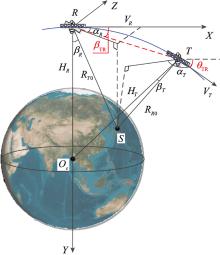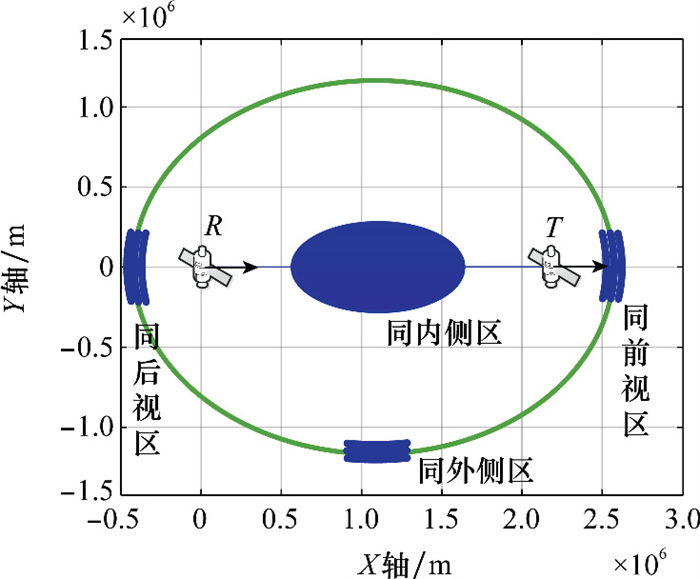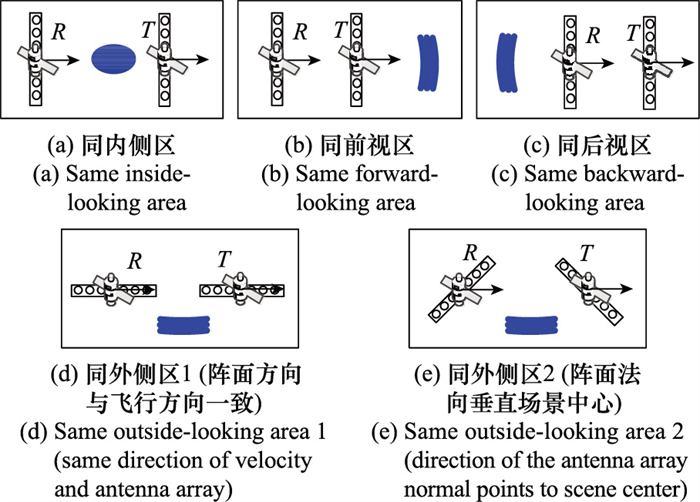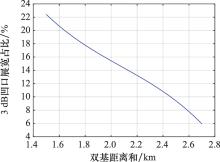Systems Engineering and Electronics ›› 2023, Vol. 45 ›› Issue (9): 2735-2743.doi: 10.12305/j.issn.1001-506X.2023.09.11
• Sensors and Signal Processing • Previous Articles Next Articles
Analysis of clutter characteristics and parameters selection for following configuration of spaceborne bistatic radar
Xiao TAN, Zhiwei YANG, Pengyuan HE, Xiangyu WU
- National Key Laboratory of Radar Signal Processing, Xidian University, Xi'an 710071, China
-
Received:2021-12-14Online:2023-08-30Published:2023-09-05 -
Contact:Zhiwei YANG
CLC Number:
Cite this article
Xiao TAN, Zhiwei YANG, Pengyuan HE, Xiangyu WU. Analysis of clutter characteristics and parameters selection for following configuration of spaceborne bistatic radar[J]. Systems Engineering and Electronics, 2023, 45(9): 2735-2743.
share this article
| 1 | CANTAFIO L J. 星载雷达手册[M]. 南京电子技术研究所, 译. 北京: 电子工业出版社, 2005. |
| CANTAFIO L J. Space-based radar handbook[M]. Nanjing Research Institute of Electronics Technology, Trans. Beijing: Publishing house of Electronics Industry, 2005. | |
| 2 | WILⅡS N J . Bistatic radar[M]. 2nd ed Raleigh: SciTech Publishing Incorporated, 2005. |
| 3 | NEZLIN D V , KOSTYLEV V I . Bistatic radar-principles and practice[M]. Birmingham: The University of Birmingham, 2007. |
| 4 |
ZHU Q M , JIN S L , MENG X L . Current developments and key technologics of foreign space based warning radars[J]. Telecommunication Engineering, 2012, 6 (6): 1054- 1058.
doi: 10.3969/j.issn.1001-893x.2012.06.047 |
| 5 | CHEMIAKOV M . Bistatic radar: emerging technology[J]. The Aeronautical Journal, 2008, 112 (1136): 620- 621. |
| 6 |
CRISTALLINI D , WALTERSCHEID I . Joint monostatic and bistatic STAP for improved SAR-GMTI capabilities[J]. IEEE Trans.on Geoscience and Remote Sensing, 2016, 54 (3): 1834- 1848.
doi: 10.1109/TGRS.2015.2489247 |
| 7 |
GRAZIANO M D . Novel constellation design method for spaceborne/airborne bistatic SAR systems[J]. IEEE Trans.on Aerospace and Electronic Systems, 2014, 50 (3): 2082- 2095.
doi: 10.1109/TAES.2014.130161 |
| 8 | ZHANG Y H, HIMED B. Effects of geometry on clutter cha-racteristics of bistatic radars[C]//Proc. of the IEEE Radar Conference, 2003: 417-424. |
| 9 |
KLEMM R . Comparison between monostatic and bistatic antenna configurations for STAP[J]. IEEE Trans.on Aerospace and Electronic Systems, 2000, 36 (2): 596- 608.
doi: 10.1109/7.845248 |
| 10 |
MELVIN W L . A STAP overview[J]. IEEE Trans.on Aerospace and Electronic Systems, 2004, 19 (1): 19- 35.
doi: 10.1109/MAES.2004.1263229 |
| 11 | ZHAN M Y, HUANG P H, LIU X Z, et al. Performance analysis of space-borne early warning radar for AMTI[C]//Proc. of the Asia-Pacific Conference on Synthetic Aperture Radar, 2019. |
| 12 | ZOU Z H, HUANG P H, LIU X Z, et al. Multi-channel sea clutter modeling and characteristics analysis for spaceborne early warning radar[C]//Proc. of the Asia-Pacific Conference on Synthetic Aperture Radar, 2019. |
| 13 | HUANG P H , ZOU Z G , XIA X G , et al. Multichannel sea clutter modeling for spaceborne early warning radar and clutter suppression performance analysis[J]. IEEE Trans.on Geoscience and Remote Sensing, 2020, 59 (10): 8349- 8366. |
| 14 | TSAO T , SLAMANI M , VARSHNEY P , et al. Ambiguity function for a bistatic radar[J]. IEEE Trans.on Aerospace and Electronic Systems, 1997, 33 (1): 1041- 1051. |
| 15 | 王越琨, 李真芳, 张金强, 等. GEO-LEO双站SAR地面分辨特性及轨道构型分析[J]. 系统工程与电子技术, 2016, 39 (5): 996- 1001. |
| WANG Y K , LI Z F , ZHANG J Q , et al. Ground resolution characteristic and orbital configuration analysis for GEO-LEO BiSAR[J]. Systems Engineering and Electronics, 2016, 39 (5): 996- 1001. | |
| 16 | WANG Y K , LU Z , SUO Z Y , et al. Optimal configuration of spaceborne bistatic SAR with GEO transmitter and LEO receiver[J]. IET Radar, Sonar & Navigation, 2019, 13 (2): 229- 235. |
| 17 | VU V T . Area resolution for bistatic ultrawideband ultrawidebeam SAR[J]. IEEE Trans.on Aerospace and Electronic Systems, 2021, 57 (20): 1371- 1377. |
| 18 |
VU V T . Derivation of bistatic SAR resolution equations based on backprojection[J]. IEEE Geoscience and Remote Sensing Letters, 2018, 15 (5): 694- 698.
doi: 10.1109/LGRS.2018.2810314 |
| 19 |
刘楠, 张林让, 易予生, 等. 星载双基地雷达空时二维杂波建模与特性分析[J]. 西安电子科技大学学报, 2009, 36 (3): 390- 395.
doi: 10.3969/j.issn.1001-2400.2009.03.002 |
|
LIU N , ZHANG L R , YI Y S , et al. Clutter modeling and analysis for spaceborne bistatic radar[J]. Journal of Xidian University, 2009, 36 (3): 390- 395.
doi: 10.3969/j.issn.1001-2400.2009.03.002 |
|
| 20 | LIU J H, LIAO G S. Spaceborne airborne bistatic radar clutter modeling and analysis[C]//Proc. of the IEEE CIE International Conference on Radar, 2011. |
| 21 |
杨璟茂, 吕晓德, 岳琦, 等. 机载双基地雷达波分类及抑制方法[J]. 雷达科学与技术, 2018, 16 (6): 608- 614.
doi: 10.3969/j.issn.1672-2337.2018.06.005 |
|
YANG J M , LYU X D , YUE Q , et al. Classification and suppression of airborne bistatic radar clutter[J]. Radar Science and Technology, 2018, 16 (6): 608- 614.
doi: 10.3969/j.issn.1672-2337.2018.06.005 |
|
| 22 |
王成浩, 廖桂生, 许京伟, 等. 超长基线双基机载雷达空时杂波建模与特性[J]. 系统工程与电子技术, 2016, 38 (10): 2258- 2266.
doi: 10.3969/j.issn.1001-506X.2016.10.06 |
|
WANG C H , LIAO G S , XU J W , et al. Modeling and characteristics analysis of space-time clutter for ultralong baseline bistatic airborne radar[J]. Systems Engineering and Electronics, 2016, 38 (10): 2258- 2266.
doi: 10.3969/j.issn.1001-506X.2016.10.06 |
|
| 23 | 李华, 汤俊, 彭应宁. 星载双基地雷达空时二维杂波建模方法[J]. 电子学报, 2008, 36 (3): 417- 420. |
| LI H , TANG J , PENG Y N . Modeling of space-time clutter for bistatic space based radar[J]. Acta Electronica Sinica, 2008, 36 (3): 417- 420. | |
| 24 |
袁博资, 王力宝, 袁俊泉, 等. 天空双基地雷达杂波建模与分析[J]. 信号处理, 2015, 31 (5): 611- 620.
doi: 10.3969/j.issn.1003-0530.2015.05.014 |
|
YUAN B Z , WANG L B , YUAN J Q , et al. Modeling and analysis of clutter for space-air based bistatic radar[J]. Journal of Signal Processing, 2015, 31 (5): 611- 620.
doi: 10.3969/j.issn.1003-0530.2015.05.014 |
|
| 25 |
何鹏远, 杨志伟, 谭啸. 星载双基地雷达杂波抑制能力分析与构型优选[J]. 系统工程与电子技术, 2022, 44 (2): 440- 447.
doi: 10.12305/j.issn.1001-506X.2022.02.11 |
|
HE P Y , YANG Z W , TAN X , et al. Performance analysis and configuration optimization of spaceborne bistatic radar[J]. Systems Engineering and Electronics, 2022, 44 (2): 440- 447.
doi: 10.12305/j.issn.1001-506X.2022.02.11 |
|
| 26 | LIU N, ZHANG L R, YI Y S, et al. Clutter modeling and analysis for spaceborne bistatic radar[C]//Proc. of the IET International Conference on Radar Systems, 2007. |
| 27 | LI H, TANG J, PENG Y N. Clutter modeling and characteristics analysis for bistatic SBR[C]//Proc. of the IEEE Radar Conference, 2007: 513-517. |
| 28 |
ZHANG Q H , WU J J , QU J Y , et al. Echo model without stop-and-go approximation for bistatic SAR with maneuvers[J]. IEEE Geoscience and Remote Sensing Letters, 2019, 16 (7): 1056- 1060.
doi: 10.1109/LGRS.2019.2891510 |
| 29 | XU Z , CHEN K S . Effects of the "stop-and-go" approximation on the lunar-based SAR imaging[J]. IEEE Geoscience and Remote Sensing Letters, 2022, 19, 4012705. |
| 30 | WARD J. Space-time adaptive processing for airborne radar[R]. Lexington: Lincoln Lab, 1994: 20-51. |
| 31 |
KHANKHOJE U K , ZYL J V , CWIK T A . Computation of radar scattering from heterogeneous rough soil using the finite-element method[J]. IEEE Trans.on Geoscience and Remote Sensing, 2013, 51 (6): 3461- 3469.
doi: 10.1109/TGRS.2012.2225431 |
| [1] | Mengyu NI, Hui CHEN, Xiaoge WANG, Binbin LI, Zhaojian ZHANG. Analysis of baseline length and clutter characteristic of co-orbital transceiver spaceborne radar [J]. Systems Engineering and Electronics, 2023, 45(8): 2498-2505. |
| [2] | Mengyu NI, Hui CHEN, Xiaoge WANG, Yang CHENG, Binbin LI. Clutter modeling and characteristic analysis of spaceborne bistatic radar [J]. Systems Engineering and Electronics, 2023, 45(4): 1024-1031. |
| [3] | Pengyuan HE, Zhiwei YANG, Xiao TAN. Performance analysis and configuration optimization of clutter repection ability of spaceborne bistatic radar [J]. Systems Engineering and Electronics, 2022, 44(2): 440-447. |
| [4] | WANG Yuekun, LI Zhenfang, ZHANG Jinqiang, JI Li. Ground resolution characteristic and orbital configuration analysis for GEO-LEO BiSAR [J]. Systems Engineering and Electronics, 2017, 39(5): 996-1001. |
| [5] | WANG Cheng-hao, LIAO Gui-sheng, XU Jing-wei, ZENG Cao. Modeling and characteristics analysis of space-time clutter for ultralong baseline bistatic airborne radar [J]. Systems Engineering and Electronics, 2016, 38(10): 2258-2266. |
| [6] | ZHANG Xi chuan, ZHANG Yong shun, XIE Wen chong, WANG Yong liang, ZHANG Zeng hui. Analysis of clutter model and DOFs for airborne MIMO radar under orthogonal degradation of waveform [J]. Journal of Systems Engineering and Electronics, 2012, 34(1): 80-84. |
| [7] | ZHANG Bai-hua, XIE Wen-chong, WANG Yong-liang, ZHANG Yong-shun. Airborne bistatic radar clutter suppression method based on maximum likelihood estimation [J]. Journal of Systems Engineering and Electronics, 2010, 32(8): 1590-1595. |
| Viewed | ||||||
|
Full text |
|
|||||
|
Abstract |
|
|||||



























